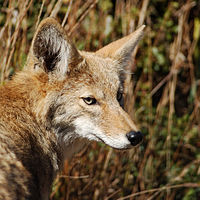Instant Skull
Contents
Interested in Contributing?
The entire Saint Michael's College coyote and domestic dog collection has been uploaded and we have no immediate plans to acquire more. If you have a coyote skull of known origin or any wolf or domestic dog skull, they would be valuable additions to this growing resource. Ways you could contribute:
- The easiest for us is of course if you become a Wikieducator and upload your own images. We upload all images first to Wikimedia Commons and then use them here.
- You could send us images with permission to upload to Wikimedia Commons under a Cc-by-sa-3.0Cc-by-sa-3.0 license.
- You could donate the skull to the Saint Michael's College collection in which case we'll photograph it and upload the images as time permits; email Declan McCabe for details: dmccabe@smcvt.edu. We do not accept loaned skulls at this time because the work is done by volunteers and undergraduate students and we do not want to run the risk of damaging a prized skull that may be impossible to replace. Donated skulls will be used for building this resource and for teaching at Saint Michael's College.
In the long term we are planning to upload a general series of skulls that would be useful for general zoology and evolution courses.
Photographic details
We used a camera mounted on a copy stand to photograph our skulls. We raised the camera to the top of the stand to minimize parallax error. To keep the long axis of each skull parallel to the plane of the camera we made a skull-shaped cradle of sorts using modeling clay and foil. After laying black fabric over the cradle we laid each skull on top and repositioned until the angle was as close to what we wanted as we could get. The cradle also included a shelf intended to be at mid elevation of the skull so that the scale bar and the center of the skull were equidistant from the camera. We used incandescent lights and set the F number at 4.5 to increase depth of focus.
We have learned more about photography as this project has developed and received explicit suggestions for improvement from anonymous reviewers. Specific ideas that will be incorporated as we add skulls and as we rephotograph existing specimens:
- Avoid covering any part of the skull with the tag.
- Adjust lighting to maximize skull detail and minimize washout.
- Reject photographs that do not place the skull in the proper alignment.
This image in particular seems to violate all of these suggestions and will be the first skull to be rephotographed as we move forward: http://wikieducator.org/File:12091206_Left_Side.JPG
Uploading Skull Images
We have decided to upload the images directly to Wikimedia Commons. This handles all of the license issues before we import the images to Wikieducator.
Numbering and file names
Avoiding previously used names is a a concern when naming the photograph files in Wikimedia Commons. For skulls at Saint Michael's College we use a simple numbering system that we also incorporate into the file name. We use the date that we log the specimen into our lab followed by 2 more digits. So the first specimen added on September 8, 2012 becomes 12090801 and the 27th skull on the same day would be 12090827. We generally don't know precisely when the specimens were collected so the date indicates only the day we curate each skull.
Does this work?
How accurately can one measure from our photograph? To answer this question we have measured the three major measurements (greatest length; Condylobasal length, and zygomatic width) on all of the coyote skulls using calipers and then using the calibrated images. We graphed and regressed caliper measurements against photographic measurements. The R squared values for these lines were all above 0.8 and we rephotographed the outliers from the graphs until all of the R squared values were above 0.9. All of the skulls measured from the photographs are within 10 millimeters of reality and the greater majority are within 2 mm of the caliper measurements. We will target the largest outliers for replacement as time permits and will change this paragraph to reflect the changes.
Acknowledging Errors
In all experiments there will be errors and to expect otherwise is overly optimistic. It is important for students to discuss these errors when writing lab reports on their data sets. The skulls on this site provide a useful example of this process.
Precision
How many decimal places are worth recording? We advocate measuring to the nearest millimeter and see no good reason to add significant figures in the tenths of millimeters.
Accuracy
The average absolute difference between photographic and caliper measurements = 2.2mm and ranges from zero difference to 9.7mm (we'll rephotograph that one).
Bias
The average of the photographic measurements minus the caliper measurements = 0.2mm suggesting a very slight bias with the photographic measurements being just two tenths of a millimeter larger. See precision above; we are not concerned about this small bias.
Systematic Bias
If all of our measurement errors were focused on Texas skulls for example, or if all of the smaller skulls were more likely to be incorrect we would have biases that could influence particular hypotheses to be tested. We have not detected such biases.
Reducing Errors
We have labeled skulls that fail our calibration test and are 7 or more mm off on one or more of the images. In most cases just one view is off and we have indicated which one to use until we have time to replace the images that fail our testing.
